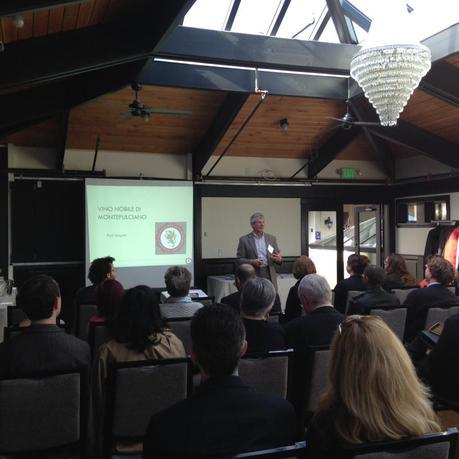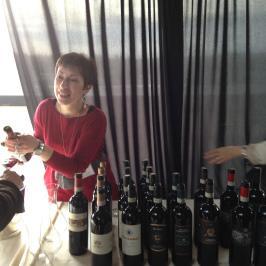
Balzac Communication brings The Tuscan wines of Montepuciano to Seattle.
Paul Wagner, owner/CEO of Balzac Communications & Marketing brings The Tuscan wines of Montepuciano to Seattle.
Balzac Communications & Marketing brings The Tuscan wines of Montepuciano to Seattle. | Image: L.M. Archer © 2014

Vino Nobile on tap at Balzac Communications & Marketing Tuscan Wines of Montepulciano media event in Seattle. | Image: L.M. Archer ©2014

It was a brief encounter. Flirtations always are. Mind you, it wasn’t cheating. Burgundy has my heart. But a bit of every wine region I visit touches my soul, including Tuscany. So when Balzac Communications proferred an invite for binNotes to Taste the Tuscan Wines of Montepulciano at the ultra-lux Hotel Ballard Rooftop Olympic Pavilion recently, a little voice inside me said “Assolutamente!” Something about Italians and their passione gets me ever time.
Many things about Montepulciano that afternoon reminded binNotes of Burgundy. Some did not.
Attitude
When it comes to wine making, Tuscany likes to complicate things – just like Burgundy! Case in point: Vino Nobile di Montepulciano is NOT the same as Montepulciano d’Abruzzo wine, made from the Montepulciano grape in central eastern Italy’s Abruzzo region.
No. Vino Nobile di Montepulciano is a wine made from at least 70% sangiovese clone prugnolo gentile (literally translated meaning ‘little prune’) with local Tuscan varietals such as canaiolo, malvasia and trebbiano rounding out the balance.
Like Burgundy’s pinot noir, sangiovese is a finicky, clone-prone diva of the vineyard. It can ripen unevenly, depending upon sun and rain variations. Wine growers and wine makers of both varietals must possess an inordinate level of patience, understanding and devotion.
Both wine regions share a penchants for limestone ridges and abundant meso-climates, though Montepulciano’s may rise a bit higher under somewhat sunnier skies.
Pedigree
Like Burgundy, Montepulciano enjoys rarified social status.
Burgundy boasts royal rootstock, including the Dukes of Burgundy and Hospices de Beaune, location of the world’s most famous annual wine auction.
Montepulciano, meaning ‘mountain of politics,‘ bedazzled popes, poets and patriarchs for centuries, earning the sobriquet “The Pearl of the 16th Century.” Today, Montepulciano serves as a Tuscan cultural, agricultural and tourist touchstone.
Status:
The wines of Burgundy and Montepulciano share patrician wine rankings as well.
Like Burgundy’s esteemed Premier and Grand Crus, Vino Nobile di Montepulciano DOCG (Denominazione di Origine Controllata e Garantita) notates wines of exceptional quality. Awarded this status in 1980, Vino Nobile di Montepulciano DOCG must age wines at least two years, three years for riservas.
Many wine aficionados complain that Vino Nobile di Montepulciano DOCG suffers from excessive hype – delivering tired, thin, astringent wine resembling a jet-lagged supermodel with acid-reflux, rather than a voluptuous opera star. However, a quick binNotes’ lip-smack of an offered Vino Nobile di Montepulciano DOCG revealed wine with a deep garnet robe, red fruit and dark cherry notes, balanced tannins, and lingering finish.
As with Burgundy, not everyone can afford rock-star status wines. While Burgundy offers regional and village-level wines for real people with real lives, Montepulciano offers these alternatives:
Rosso di Montepulciano DOC
Rosso di Montepulciano DOC ( Denominazione di Origine Controllata) resemble Burgundy’s regional and village level wines - younger, softer, and typically from younger vines, with shorter aging requirements.
Vin Santo di Montepulciano DOC
Vin Santo, meaning ‘holy wine,’ traditionally appeared at Mass and celebrations. Today, Vin Santo di Montepulciano DOC enjoys a secular place at the table, typically with dessert or postprandial.
Note: Some wine professionals argue that this wine deserves the same DOCG status as Vino Nobile di Montepulciano DOCG. What do you think? Leave your comments below.
Endnotes:
binNotes left ‘The Tuscan Wines of Montepulciano’ blushing, but still devoted to Burgundy. Bourgogne toujours…ma avremo sempre Montepulciano! Ciao et santé!
For more on Montepulciano, check out this cool Rick Steves video:
Video: Courtesy http://www.ricksteves.com
Thank you:
Balzac Communications and Marketing
The Hotel Ballard

